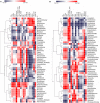High-Throughput Sequencing-Based Analysis of Rhizosphere and Diazotrophic Bacterial Diversity Among Wild Progenitor and Closely Related Species of Sugarcane (Saccharum spp. Inter-Specific Hybrids)
- PMID: 35283913
- PMCID: PMC8908384
- DOI: 10.3389/fpls.2022.829337
High-Throughput Sequencing-Based Analysis of Rhizosphere and Diazotrophic Bacterial Diversity Among Wild Progenitor and Closely Related Species of Sugarcane (Saccharum spp. Inter-Specific Hybrids)
Abstract
Considering the significant role of genetic background in plant-microbe interactions and that most crop rhizospheric microbial research was focused on cultivars, understanding the diversity of root-associated microbiomes in wild progenitors and closely related crossable species may help to breed better cultivars. This study is aimed to fill a critical knowledge gap on rhizosphere and diazotroph bacterial diversity in the wild progenitors of sugarcane, the essential sugar and the second largest bioenergy crop globally. Using a high-throughput sequencing (HTS) platform, we studied the rhizosphere and diazotroph bacterial community of Saccharum officinarum L. cv. Badila (BRS), Saccharum barberi (S. barberi) Jesw. cv Pansahi (PRS), Saccharum robustum [S. robustum; (RRS), Saccharum spontaneum (S. spontaneum); SRS], and Saccharum sinense (S. sinense) Roxb. cv Uba (URS) by sequencing their 16S rRNA and nifH genes. HTS results revealed that a total of 6,202 bacteria-specific operational taxonomic units (OTUs) were identified, that were distributed as 107 bacterial groups. Out of that, 31 rhizobacterial families are commonly spread in all five species. With respect to nifH gene, S. barberi and S. spontaneum recorded the highest and lowest number of OTUs, respectively. These results were validated by quantitative PCR analysis of both genes. A total of 1,099 OTUs were identified for diazotrophs with a core microbiome of 9 families distributed among all the sugarcane species. The core microbiomes were spread across 20 genera. The increased microbial diversity in the rhizosphere was mainly due to soil physiochemical properties. Most of the genera of rhizobacteria and diazotrophs showed a positive correlation, and few genera negatively correlated with the soil properties. The results showed that sizeable rhizospheric diversity exists across progenitors and close relatives. Still, incidentally, the rhizosphere microbial abundance of progenitors of modern sugarcane was at the lower end of the spectrum, indicating the prospect of Saccharum species introgression breeding may further improve nutrient use and disease and stress tolerance of commercial sugarcane. The considerable variation for rhizosphere microbiome seen in Saccharum species also provides a knowledge base and an experimental system for studying the evolution of rhizobacteria-host plant association during crop domestication.
Keywords: 16S rRNA; diazotroph diversity; nifH; rhizosphere soil; sugarcane.
Copyright © 2022 Malviya, Li, Lakshmanan, Solanki, Wang, Solanki, Nong, Verma, Singh, Singh, Sharma, Guo, Dessoky, Song and Li.
Conflict of interest statement
The authors declare that the research was conducted in the absence of any commercial or financial relationships that could be construed as a potential conflict of interest.
Figures









Similar articles
-
Unraveling Nitrogen Fixing Potential of Endophytic Diazotrophs of Different Saccharum Species for Sustainable Sugarcane Growth.Int J Mol Sci. 2022 Jun 2;23(11):6242. doi: 10.3390/ijms23116242. Int J Mol Sci. 2022. PMID: 35682919 Free PMC article.
-
Diversity of the Bacterial Microbiome in the Roots of Four Saccharum Species: S. spontaneum, S. robustum, S. barberi, and S. officinarum.Front Microbiol. 2018 Feb 21;9:267. doi: 10.3389/fmicb.2018.00267. eCollection 2018. Front Microbiol. 2018. PMID: 29515548 Free PMC article.
-
An enriched sugarcane diversity panel for utilization in genetic improvement of sugarcane.Sci Rep. 2020 Aug 7;10(1):13390. doi: 10.1038/s41598-020-70292-8. Sci Rep. 2020. PMID: 32770152 Free PMC article.
-
A short review on sugarcane: its domestication, molecular manipulations and future perspectives.Genet Resour Crop Evol. 2022;69(8):2623-2643. doi: 10.1007/s10722-022-01430-6. Epub 2022 Sep 16. Genet Resour Crop Evol. 2022. PMID: 36159774 Free PMC article. Review.
-
Domestication to crop improvement: genetic resources for Sorghum and Saccharum (Andropogoneae).Ann Bot. 2007 Nov;100(5):975-89. doi: 10.1093/aob/mcm192. Epub 2007 Sep 1. Ann Bot. 2007. PMID: 17766842 Free PMC article. Review.
Cited by
-
Comparative metataxonamic analyses of seeds and leaves of traditional varieties and hybrids of cucumber (Cucumis sativus L.) reveals distinct and core microbiome.Heliyon. 2023 Sep 15;9(9):e20216. doi: 10.1016/j.heliyon.2023.e20216. eCollection 2023 Sep. Heliyon. 2023. PMID: 37809962 Free PMC article.
-
Physiological and molecular insights into the resilience of biological nitrogen fixation to applied nitrogen in Saccharum spontaneum, wild progenitor of sugarcane.Front Plant Sci. 2023 Jan 13;13:1099701. doi: 10.3389/fpls.2022.1099701. eCollection 2022. Front Plant Sci. 2023. PMID: 36714748 Free PMC article.
-
Response of abundance, diversity, and network of rhizosphere fungal community to monoculture of cut chrysanthemum.Appl Microbiol Biotechnol. 2023 Jun;107(11):3673-3685. doi: 10.1007/s00253-023-12542-z. Epub 2023 Apr 28. Appl Microbiol Biotechnol. 2023. PMID: 37115253
-
Metagenome-based diversity and functional analysis of culturable microbes in sugarcane.Microbiol Spectr. 2025 Jan 7;13(1):e0198224. doi: 10.1128/spectrum.01982-24. Epub 2024 Nov 19. Microbiol Spectr. 2025. PMID: 39560390 Free PMC article.
-
Microbiome Analysis of Sugarcane Juices and Biofilms from Louisiana Raw Sugar Factories.Microbiol Spectr. 2023 Jun 15;11(3):e0434522. doi: 10.1128/spectrum.04345-22. Epub 2023 May 10. Microbiol Spectr. 2023. PMID: 37162339 Free PMC article.
References
-
- Amna Xia, Y., Farooq M. A., Javed M. T., Kamran M. A., Mukhtar T., Ali J., et al. . (2020). Multi-stress tolerant PGPR Bacillus xiamenensis PM14 activating sugarcane (Saccharum officinarum L.) red rot disease resistance. Plant Physiol. Biochem. 151, 640–649. 10.1016/j.plaphy.2020.04.016 - DOI - PubMed
-
- Antoun H., Prévost D. (2005). “Ecology of plant growth promoting rhizobacteria,” in PGPR: Biocontrol and Biofertilization, ed Z. A. Siddiqui (Netherlands: Springer; ), 1–38. 10.1007/1-4020-4152-7_1 - DOI
LinkOut - more resources
Full Text Sources
Miscellaneous

